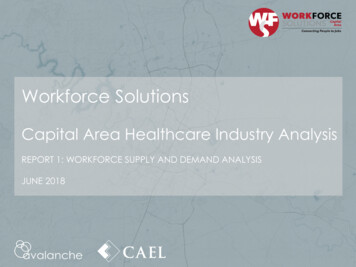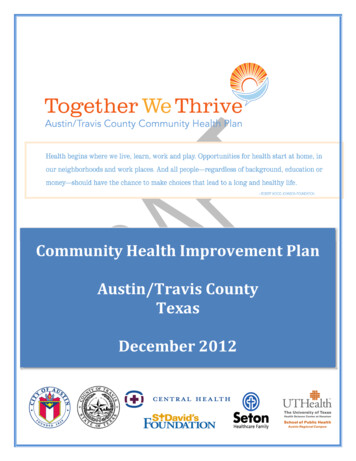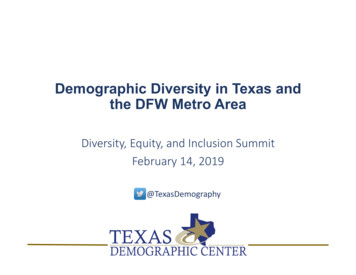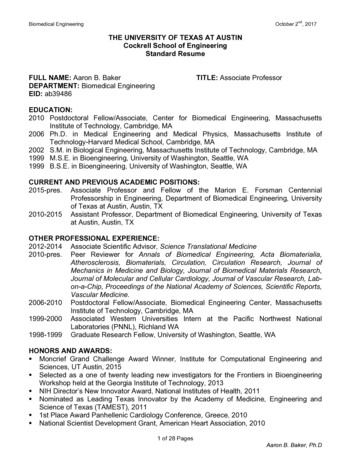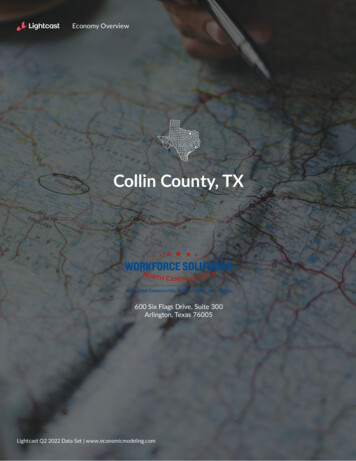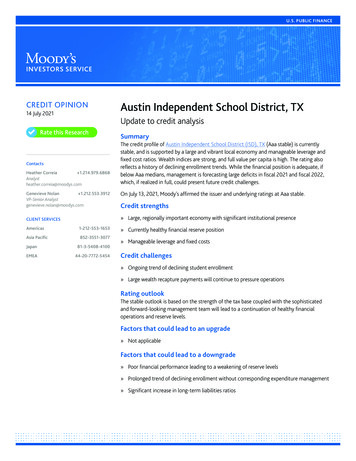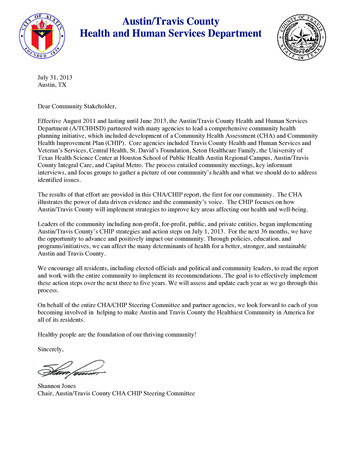
Transcription
Austin/Travis CountyHealth and Human Services DepartmentJuly 31, 2013Austin, TXDear Community Stakeholder,Effective August 2011 and lasting until June 2013, the Austin/Travis County Health and Human ServicesDepartment (A/TCHHSD) partnered with many agencies to lead a comprehensive community healthplanning initiative, which included development of a Community Health Assessment (CHA) and CommunityHealth Improvement Plan (CHIP). Core agencies included Travis County Health and Human Services andVeteran’s Services, Central Health, St. David’s Foundation, Seton Healthcare Family, the University ofTexas Health Science Center at Houston School of Public Health Austin Regional Campus, Austin/TravisCounty Integral Care, and Capital Metro. The process entailed community meetings, key informantinterviews, and focus groups to gather a picture of our community’s health and what we should do to addressidentified issues.The results of that effort are provided in this CHA/CHIP report, the first for our community. The CHAillustrates the power of data driven evidence and the community’s voice. The CHIP focuses on howAustin/Travis County will implement strategies to improve key areas affecting our health and well-being.Leaders of the community including non-profit, for-profit, public, and private entities, began implementingAustin/Travis County’s CHIP strategies and action steps on July 1, 2013. For the next 36 months, we havethe opportunity to advance and positively impact our community. Through policies, education, andprograms/initiatives, we can affect the many determinants of health for a better, stronger, and sustainableAustin and Travis County.We encourage all residents, including elected officials and political and community leaders, to read the reportand work with the entire community to implement its recommendations. The goal is to effectively implementthese action steps over the next three to five years. We will assess and update each year as we go through thisprocess.On behalf of the entire CHA/CHIP Steering Committee and partner agencies, we look forward to each of youbecoming involved in helping to make Austin and Travis County the Healthiest Community in America forall of its residents.Healthy people are the foundation of our thriving community!Sincerely,Shannon JonesChair, Austin/Travis County CHA CHIP Steering Committee
- ROBERT WOOD JOHNSON FOUNDATIONCommunity Health AssessmentAustin/Travis CountyTexasDecember 2012
Table of ContentsEXECUTIVE SUMMARY . viiiINTRODUCTION . 1Purpose and Geographic Scope of the Austin/Travis County Community Health Assessment. 1Structure of Engagement . 2METHODS . 3Social Determinants of Health Framework . 3Quantitative Data: Reviewing Existing Secondary Data. 4Qualitative Data: Forums, Focus Groups, and Interviews . 4Limitations. 6DEMOGRAPHICS – Who lives in Austin/Travis County? . 7Population . 7Age Distribution . 8Racial and Ethnic Diversity . 9Educational Attainment . 10Income, Poverty, and Employment. 11SOCIAL AND PHYSICAL ENVIRONMENT – What is the Austin/Travis County community like?. 16Geographic Disparities . 17Transportation . 19Housing . 20Access to Healthy Food and Physical Activity . 23Environmental Quality . 25Crime and Safety . 25COMMUNITY STRENGTHS AND RESOURCES . 28Social and Human Capital . 28Access to Services . 29Organizational Leadership and Partnerships . 29HEALTH BEHAVIORS . 29Obesity . 30Healthy Eating and Physical Activity . 31Substance Use . 35HEALTH OUTCOMES. 39Leading Causes of Death . 39Chronic Disease . 40Mental Health . 45Maternal and Child Health . 47Oral Health . 49Communicable Diseases . 50HEALTH CARE ACCESS AND AFFORDABILITY . 54Health Care Facilities and Resources . 54Emergency Room Use . 58Navigating the Healthcare System . 58Health Insurance and Cost . 59EXTERNAL FACTORS (“Forces of Change”) . 61Population Growth and Demographic Shifts . 62Fiscal Environment . 62Political Environment . 62Fragmented Organizational Efforts . 62
COMMUNITY’S VISION AND IDENTIFIED OPPORTUNITIES . 63Focus on Prevention . 63Equitable Access to Health Care . 63Improved Built Environment . 63Policy Change and Strategic City/County Planning . 64KEY THEMES AND SUGGESTIONS . 64APPENDIX A. COMMUNITY FORUM QUESTIONS . 67APPENDIX B. FULL LIST OF FOCUS GROUP AND INTERVIEW SECTORS . 68APPENDIX C. FOCUS GROUP GUIDE . 69APPENDIX D. KEY INFORMANT INTERVIEW GUIDE . 72REFERENCES . 76This report is available at the Austin / Travis County Health and HumanServices Department’s website at: http://www.austintexas.gov/healthforum.For additional information, or comments, please e-mailCHACHIP@austintexas.gov or contact us by phone at 512-972-5888.
Dear Community Partner,From August 2011 through July 2012, Austin/Travis County Health and Human Services Department(A/TCHHSD) partnered with Travis County Health and Human Services and Veterans Services, CentralHealth, St. David’s Foundation, Seton Healthcare Family, and the University of Texas Health ScienceCenter (UTHSC) at Houston School of Public Health Austin Regional Campus to lead a comprehensivecommunity health planning initiative. The Austin/Travis County Community Health Assessment (CHA)represents a collaborative and community participatory process in order to illustrate our health status,strengths, and opportunities for the future.Through the CHA community activities and events, the voices of our city and county contributed to anengaging and substantive process. While every person or agency may not share the same viewpoint,capturing the community’s voice is essential so we, as a community, can work together to identifystrengths, capacity, and opportunity to better address the many determinants of health.The drive, diligence, and support from the core partners—our Austin/Travis County CHA team—madeplanning, conducting, and completing this assessment possible. This has truly been a collaborativeexperience.As we move forward to develop collaborative plans and strategies to improve the health and wellbeingfor all community members, remember that your story builds our story. Thank you for your ongoingcontributions to this remarkable community health improvement process.Sincerely,Carlos RiveraDirector, Austin/Travis County HHSDShannon JonesChair of Steering CommitteeDeputy Director, Austin/Travis County HHSDPhilip HuangHealth Authority, Austin/Travis County HHSDiv
AcknowledgementsThe dedication, expertise, and leadership of the following agencies and people made the 2012 Austin /Travis County Community Health Assessment a collaborative, engaging, and substantive plan that willguide our community in developing a Community Health Improvement Plan. Special thanks to all of you.Austin/Travis County appreciates the National Association of County and City Health Officials (NACCHO)and the Robert Wood Johnson Foundation (RWJF) for their selection of Austin/Travis County HHSD as aDemonstration Site for Community Health Improvement Planning and Accreditation Preparation. Thankyou NACCHO and RWJF for your guidance and training.To the participants in the focus groups, forums, key informant interviews and the staff from our coreagencies and partners/stakeholders: Your voice and leadership are invaluable. We are grateful that weare in this together now and moving forward.To Health Resources in Action, for their strategic community health improvement planning expertise,insight, and passion from data analysis to facilitation to report writing.To Suma Orchard Social Marketing, for working with us to design the Together We Thrive logo and onepage talking points tool.Thank you to HEB for donating healthy food and water for the Community Forums.Steering CommitteeChair: Shannon Jones, Austin/Travis County Health and Human Services DepartmentBobbie Barker, St. David's FoundationAshton Cumberbatch, Seton Healthcare FamilySherri Fleming, Travis County Health and Human Services & Veterans ServicesChristie Garbe, Central HealthStephanie Hayden, Austin/Travis County Health and Human Services DepartmentPhilip Huang, Austin/Travis County Health and Human Services DepartmentHarold (Bill) Kohl, University of Texas Health Science Center at Houston School of Public Health AustinRegional CampusBlanca Leahy, Travis County Health and Human Services & Veterans ServicesCheryl Perry, University of Texas Health Science Center at Houston School of Public Health AustinRegional CampusCarlos Rivera, Austin/Travis County Health and Human Services DepartmentCore Coordinating Committee and Data & Research SubcommitteeProject Manager and Core Coordinating Chair: Veena Viswanathan, Austin/Travis County HHSDData & Research Chair: Janet Pichette, Austin/Travis County HHSDAna Almaguel, Travis County HHS & VSSherry Lyles, Austin/Travis County HHSDVictoria Bailey, Austin/Travis County HHSDLawrence Lyman, Travis County HHS & VSJill Campbell, Austin/Travis County HHSDAllan McCracken, Austin/Travis County HHSDKatie Coburn, Central HealthKristi Metzger, Austin/Travis County HHSDHeather Cooks-Sinclair, Austin/Travis County HHSDRaquel Moreno, Austin/Travis County HHSDTeresa Griffin, Seton Healthcare FamilyCourtney Ousley, Central HealthJudy Henry, Austin/Travis County HHSDBecky Pastner, St. David's FoundationSuling Homsy, Central HealthElla Puga, Austin/Travis County HHSDRon Hubbard, Austin/Travis County HHSDEllen Richards, Central HealthCindy Jaso, Austin/Travis County HHSDAmy Thompson, Austin/Travis County HHSDVella Karman, Austin/Travis County HHSDElizabeth Vela, Travis County HHS & VSKen Whelan, Austin/Travis County HHSDv
Austin/Travis County HHSD Administration and LogisticsForum Chair: Filip GecicLogistics Chair: Sherryl DeCampoSharon AlexanderCarole BaraschVince CobalisLinda CoxChris CrookhamLori DoubravaSusan GehringAndrea GuerraKimberly HallOlga HernandezNatasha HillJoyce IkkandaDavid LopezPaul SteinCity of Austin Mayor’s OfficeSly MajidCity of Austin Planning and Development ReviewGregory ClaxtonCarol HaywoodRyan RobinsonGarner StollCity of Austin Public Information OfficeJill GoodmanLarry SchoolerOutreach and Engagement Subcommittee (virtual)Co-Chairs: Sherri Fleming, Travis County HHS & VS; Philip Huang, Austin/Travis County HHSD;Blanca Leahy, Travis County HHS & VS; and Paul Scott, One Voice Central TexasKatie Coburn, Central HealthAshton Cumberbatch, Seton Healthcare FamilyAlexandra Evans, University of Texas Health Science Center at Houston School of Public Health AustinRegional CampusAnna Lisa Fahrenthold, Travis County HHS & VSJohn McNabb One Voice Central TexasBecky Pastner, St. David’s FoundationAndrew Springer, University of Texas Health Science Center at Houston School of Public Health AustinRegional CampusSuki Steinhauser, One Voice Central TexasWillie Williams, Austin/Travis County HHSDvi
Focus Group, Key Informant, and Community Forum Participating Agencies2Thrive4Lone Star Circle of CareAmerigroup Texas, Inc.Manor Independent School DistrictAny Baby CanMayor's Fitness CouncilAsian American Chamber of CommerceMeals on WheelsAustin Area FundersMt. Zion Baptist ChurchAustin Community CollegeNational Alliance on Mental Illness (NAMI) AustinAustin Independent School DistrictNational Association for the Advancement ofAustin Lakes HospitalColored People, (NAACP) Austin ChapterAustin Partners in EducationNetwork of Asian American OrganizationsOne Life One GoalAustin RecoveryOne Voice Central TexasAustin/Travis County Emergency Medical ServicesPeople FundAustin/Travis County Health and Human ServicesAustin/Travis County Integral CarePflugerville Independent School DistrictBlack Minister's Alliance Baptist ChurchSAHELIBlackland Community Development CenterSANDE Youth ProjectBlue Cross Blue Shield of TexasSelf Help Advocacy CenterCentral HealthSeton Healthcare FamilyChildren’s Optimal HealthSickle Cell Association of Austin Marc ThomasCity of Austin Council MembersFoundationCity of Austin, Economic Growth & RedevelopmentSt. David’s FoundationServices OfficeTravis County Commissioners CourtCity of Austin Parks and Recreation DepartmentTravis County Health and Human Services &City of Austin Planning and Development ReviewVeterans ServicesCommunities in SchoolsTravis County Sherriff's OfficeCommunity Action NetworkTravis County Medical Examiner’s OfficeCommUnity CareUnited Way for Greater AustinDel Valle Independent School DistrictUniversity of Texas at Austin Children's WellnessDell Children's Medical Center of Central TexasCenterFamily EldercareUniversity of Texas Health Science Center atFoundation CommunitiesHouston School of Public Health AustinDell Children's Medical Center of Central TexasRegional CampusFamily EldercareUniversity of Texas School of NursingFoundation CommunitiesVentanilla de Salud, Consulate General of MexicoHispanic American Chamber of CommerceHousing Authority of the City of AustinIndicator InitiativeInterfaith Action of Central Texas (iACT)vii
AUSTIN/TRAVIS COUNTY COMMUNITY HEALTH ASSESSMENTEXECUTIVE SUMMARYIntroductionHealth is affected by where and how we live, work, play, and learn.1 Understanding these factors andhow they influence health is critical to efforts aimed to improve the health of the community.Identifying the health issues of an area and their larger context and then developing a plan to addressthem are key steps in the larger health planning process. To accomplish these goals, Austin/TravisCounty Health and Human Services – in collaboration with Travis County Health and Human Services &Veterans Services, Central Health, St. David’s Foundation, Seton Healthcare Family, and the University ofTexas Health Science Center at Houston School of Public Health Austin Regional Campus – is leading acomprehensive community health planning effort to measurably improve the health of Austin/TravisCounty, TX residents. This effort entails two major phases:1. A community health assessment (CHA) to identify the health-related needs and strengths ofAustin/Travis County2. A community health improvement plan (CHIP) to determine major health priorities, overarchinggoals, and specific strategies to be implemented in a coordinated way across Austin/TravisCountyThis report discusses the findings from the CHA, which was conducted August 2011–June 2012, using acollaborative, participatory approach. These findings will inform discussions and priority areas for theCHIP, scheduled to take place July 2012 - December 2012.The December 2012 Austin/Travis County CHA1 was conducted to fulfill several overarching goals,specifically: To examine the current health status across Austin/Travis County as compared to state andnational indicators To explore the current health concerns among Austin/Travis County residents within the socialcontext of their communities To identify community strengths, resources, forces of change, and gaps in services to informfunding and programming priorities of Austin/Travis CountyThis CHA focuses on Travis County which is home to numerous communities as well as Austin, thecapital city of Texas. While the largest proportion of the population in Travis County resides in Austin,given the fluidity of where people work and live in the County and that numerous service organizationsin the area serve individuals across the County, a focused effort was made to include data and thecommunity voice from across the County.MethodsThe CHA defines health in the broadest sense and recognizes numerous factors at multiple levels– fromlifestyle behaviors (e.g., diet and exercise) to clinical care (e.g., access to medical services) to social andeconomic factors (e.g., employment opportunities) to the physical environment (e.g., air quality) – allhave an impact on the community’s health. Existing social, economic, and health data were drawn fromnational, state, county, and local sources, such as the U.S. Census and Texas Department of State HealthServices, which include self-report, public health surveillance, and vital statistics data. Over 300individuals from multi-sector organizations, community stakeholders, and residents were engaged in1The 2012 Austin/Travis County CHA was drafted in August 2012 and finalized in December 2012.viii
community forums, focus groups, and interviews to gauge their perceptions of the community, theirhealth concerns, and what programming, services, or initiatives are most needed to address theseconcerns.Demographics – Who lives in Austin/Travis County?The population of Austin/Travis County is ethnically and linguistically diverse, with wide variations insocioeconomic level, and is experiencing rapid growth, including demographic shifts among the aging,Hispanic, and Asian populations. The population of Travis County has grown by over 25% in the past decade 2and is expected to morethan double in the next three decades, from a population of 1,024,266 in 2010 to 2.3 millionresidents in 2045.3 Specifically of note is the changing composition of the population in terms ofage, cultural background, and socioeconomic status. While Austin was often described as youthful, concerns regarding an increasing and often“forgotten” aging population were frequently expressed. According to the U.S. Census, from 2000to 2010, the senior population (aged 65 years and over) in Travis County grew by over 25%.4 Many participants described the region (Austin/Travis County) as ethnically and linguistically diverse.In 2010, approximately half of the population of Travis County was non-Hispanic White, withgrowing Latino/Hispanic and Asian populations and a proportionally decreasing Black/AfricanAmerican population.5 Overall, the region was described by participants as highly educated; however, this was contrastedby perceived low levels of educational attainment, specifically among the economicallydisadvantaged. Over 40% of Travis County adults (25 years or older) had a bachelor’s degree orhigher compared to 25.9% of Texas adults.6 While the median income was higher in Travis County ( 51,743) than the State overall ( 48,615),poverty disproportionately affects certain segments of the population, mainly Latinos/Hispanics(26.8% living in poverty) and Blacks/African Americans (21.2% living in poverty).7Social and Physical Environment – What is the Austin/Travis County community like?The wide variations in demographic characteristics of Austin/Travis County result in geographicdisparities across the region where residents lack access to services and resources. The east-west divide (physically defined by I-35), as well as differences between urban and ruralcommunities were prominent themes across interviews and focus groups.“My aunt is diabetic Participants described Travis County as a largely car-dependent region, notand she has stomachsupporting other modes of transportation, such as walking or biking. The lackproblems and it’sof a robust public transportation system was noted as a challenge tohard for her to catchconducting everyday activities.the bus with three Residents described struggling to pay high rent prices and an increasingchildren. When she’son the bus she has todemand for affordable housing resulting in long waiting lists to access Sectiontake all the groceries8 housing. Quantitative data confirm an increase in both housing (31.1%) andand carry the babyrenting costs (22%) in Austin between 2000 and 2009, which were similar to or8also.”– Focus groupless than increases seen statewide.participant The existence of food deserts was a prominent theme through key informantinterviews. In 2006, 8.7% of Travis County’s low-income population did not live within one mile of agrocery store.9 Healthy food that is available was described by residents as unaffordable.10 Despite a higher rate of recreational facilities in Travis County (11.1 facilities per 100,000population) than in Texas as a whole (7.2 facilities per 100,000 population), unequal geographic andfinancial access to green space and recreational facilities was a concern among participants.11ix
Community Strengths and ResourcesFocus group and interview participants identified several community strengths and assets, includingsocial and human capital, access to services, and organizational leadership and partnerships. Many participants described Austin as an entrepreneurial and liberal city that is politically active andculturally rich. Neighborhood cohesion and community engagement among residents were alsohighlighted as assets. Despite the challenges to accessing services mentioned in previous sections, residents did note themultitude of resources available to them in their community, if one knows how to access them. Similarly, community-based and non-for-profit organizations were described as assets, especiallytheir willingness to collaborate, and committed and innovative leadership.Health BehaviorsA majority of key informants, including Central Health Connection interviewees, considered obesity tobe a pressing health issue, particularly among children and in relation to other chronic diseases suchas diabetes and heart disease. Interview participants discussed the importance of and challenges to nutrition and exercise,especially highlighting the disparities among Blacks/African Americans and Latinos/Hispanics. In 2010, the percentage of obese adults in Travis County (24.0%) was less than that of the state(29.6%); however, Blacks/African Americans and Latinos/Hispanics experienced much higher rates ofobesity, 41.7% and 36.5% respectively, compared to less than 20% of Whites (19.4%).12Health OutcomesWhile chronic diseases emerged as a key concern among participants and represent the leading causesof death in the region, the need for mental health services was the foremost community healthconcern raised by residents. Additionally, it is evident that Blacks/African Americans andLatinos/Hispanics experience disproportionately higher rates of several health outcomes. Cancer and heart disease were theFigure 1: Age-Adjusted Mortality Rate per 100,000 Population for theleading causes of death in Travis CountyLeading Causes of Mortality by Race/Ethnicity in Travis County, 2005-2009between 2005 and 2009, withBlacks/African Americans experiencingdisparate rates of mortality due tocancer and heart disease (Figure 1). Approximately 20% of Travis Countyadults experienced five or more days ofpoor mental health in the past month. Agreater proportion of Blacks/AfricanAmericans (24.3%) and Latinos/Hispanics(26.6%) reported poor mental healththan did Whites in the County (17.9%).13** Indicated a numerator too small for rate calculationDATA SOURCE: Texas Department of State Health Services, Texas HealthData: Deaths (2005-2009).x
Health Care Access and AffordabilityAccess to health care was a predominant theme among residents, specifically the availability andaccessibility of health care facilities and resources, emergency room overuse, challenges of navigatinga complex health care system, and health insurance and cost relatedbarriers.“People we serve have anumberof jobs so they’re Focus group and interview participants repeatedly cited thetoobusytogo see doctor orchallenges of accessing health care, such as transportation,employerswon’t let themlanguage, and cost barriers. Yet Travis County adults were moretake time off to go to thelikely to have health insurance or their own health care providerdoctor or they’re afraid theycompared to rates statewide. The Latino/Hispanic population inwill lose their job.”Travis County had disproportionately lower rates of either of these– Interview participantindicators.14External Factors (“Forces of Change”)The primary external factors recognized by part
2Thrive4 Lone Star Circle of Care Amerigroup Texas, Inc. Manor Independent School District Any Baby Can Mayor's Fitness Council Asian American Chamber of Commerce Meals on Wheels Austin Area Funders Mt. Zion Baptist Church Austin Community College National Alliance on Mental Illness (NAMI) Austin Austin Independent School District
